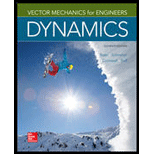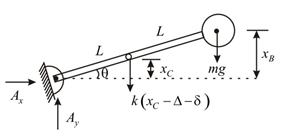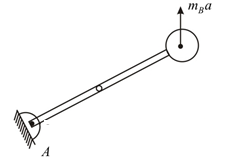
Concept explainers
(a)
Magnitude of maximum angular velocity of bar
Answer to Problem 19.107P
The maximum angular velocity of bar AB is
Explanation of Solution
Given:
Mass of attached sphere is
Spring constant is
Vertical deflection is
Maximum amplitude of deflection is
Frequency of rotation is
Concept used:
Draw the FBD for bar AB in equilibrium state.

After giving small deflection to bar AB, Draw FBD of bar AB

Draw the equivalent kinetic diagram for bar AB as.

Write the expression for displacement of point C in terms of angular displacement.
Here,
Write the expression for displacement of point B in terms of angular displacement.
Here,
Substitute
Take moment about point A for equilibrium position.
For static equilibrium substitute
Simplify the above expression.
Here,
Take moment about point A after giving the angular displacement.
Substitute
Substitute
Substitute
Substitute
Substitute
Rearrange the above expression as.
Here,
Write the standard equation of motion as.
Compare the coefficient of
Compare the coefficient of
Write the expression for maximum amplitude of force.
Here,
Write the expression for natural frequency of system.
Here,
Write the expression for the amplitude of vibration of sphere B.
Here,
Write the expression for magnitude of maximum angular velocity of bar AB.
Here,
Calculation:
Substitute
Substitute
Substitute
Substitute
Substitute
Substitute
The maximum angular velocity of bar AB is
Conclusion:
Thus, the maximum angular velocity of bar AB is
(b)
Magnitude of maximum acceleration of sphere
Answer to Problem 19.107P
The maximum acceleration of sphere is
Explanation of Solution
Concept used:
Write the expression for maximum acceleration of sphere.
Here,
Calculation:
Substitute
The maximum acceleration of sphere is
Conclusion:
Thus, the maximum acceleration of sphere is
Want to see more full solutions like this?
Chapter 19 Solutions
Vector Mechanics for Engineers: Dynamics
- please solve this problems follow what the question are asking to do please show me step by steparrow_forwardplease first write the line action find the forces and them solve the problem step by steparrow_forwardplease solve this problem what the problem are asking to solve please explain step by step and give me the correct answerarrow_forward
- please help me to solve this problem step by steparrow_forwardplease help me to solve this problem and determine the stress for each point i like to be explained step by step with the correct answerarrow_forwardplease solve this problem for me the best way that you can explained to solve please show me the step how to solvearrow_forward
- plese solbe this problem and give the correct answer solve step by step find the forces and line actionarrow_forwardplease help me to solve this problems first write the line of action and them find the forces {fx=0: fy=0: mz=0: and them draw the shear and bending moment diagram. please explain step by steparrow_forwardplease solve this problem step by step like human and give correct answer step by steparrow_forward
- PROBLEM 11: Determine the force, P, that must be exerted on the handles of the bolt cutter. (A) 7.5 N (B) 30.0 N (C) 52.5 N (D) 300 N (E) 325 N .B X 3 cm E 40 cm cm F = 1000 N 10 cm 3 cm boltarrow_forwardUsing the moment-area theorems, determine a) the rotation at A, b) the deflection at L/2, c) the deflection at L/4. (Hint: Use symmetry for Part a (θA= - θB, or θC=0), Use the rotation at A for Parts b and c. Note that all deformations in the scope of our topics are small deformation and for small θ, sinθ=θ).arrow_forwardDistilled water is being cooled by a 20% propylene glycol solution in a 1-1/U counter flow plate and frame heat exchanger. The water enters the heat exchanger at 50°F at a flow rate of 86,000 lbm/h. For safety reasons, the water outlet temperature should never be colder than 35°F. The propylene glycol solution enters the heat exchanger at 28°F with a flow rate of 73,000 lbm/h. The port distances on the heat exchanger are Lv = 35 in and Lh = 18 in. The plate width is Lw = 21.5 2 in. The plate thickness is 0.04 in with a plate pitch of 0.12 in. The chevron angle is 30° and the plate enlargement factor is 1.17. All ports have a 2 in diameter. The fouling factor of the propylene glycol solution can be estimated as 2 ×10−5 h-ft2-°F/Btu. a. Determine the maximum number of plates the heat exchanger can have while ensuring that the water outlet temperature never drops below 35°F. b. Determine the thermal and hydraulic performance of the heat exchanger with the specified number of plates.…arrow_forward
 Elements Of ElectromagneticsMechanical EngineeringISBN:9780190698614Author:Sadiku, Matthew N. O.Publisher:Oxford University Press
Elements Of ElectromagneticsMechanical EngineeringISBN:9780190698614Author:Sadiku, Matthew N. O.Publisher:Oxford University Press Mechanics of Materials (10th Edition)Mechanical EngineeringISBN:9780134319650Author:Russell C. HibbelerPublisher:PEARSON
Mechanics of Materials (10th Edition)Mechanical EngineeringISBN:9780134319650Author:Russell C. HibbelerPublisher:PEARSON Thermodynamics: An Engineering ApproachMechanical EngineeringISBN:9781259822674Author:Yunus A. Cengel Dr., Michael A. BolesPublisher:McGraw-Hill Education
Thermodynamics: An Engineering ApproachMechanical EngineeringISBN:9781259822674Author:Yunus A. Cengel Dr., Michael A. BolesPublisher:McGraw-Hill Education Control Systems EngineeringMechanical EngineeringISBN:9781118170519Author:Norman S. NisePublisher:WILEY
Control Systems EngineeringMechanical EngineeringISBN:9781118170519Author:Norman S. NisePublisher:WILEY Mechanics of Materials (MindTap Course List)Mechanical EngineeringISBN:9781337093347Author:Barry J. Goodno, James M. GerePublisher:Cengage Learning
Mechanics of Materials (MindTap Course List)Mechanical EngineeringISBN:9781337093347Author:Barry J. Goodno, James M. GerePublisher:Cengage Learning Engineering Mechanics: StaticsMechanical EngineeringISBN:9781118807330Author:James L. Meriam, L. G. Kraige, J. N. BoltonPublisher:WILEY
Engineering Mechanics: StaticsMechanical EngineeringISBN:9781118807330Author:James L. Meriam, L. G. Kraige, J. N. BoltonPublisher:WILEY





